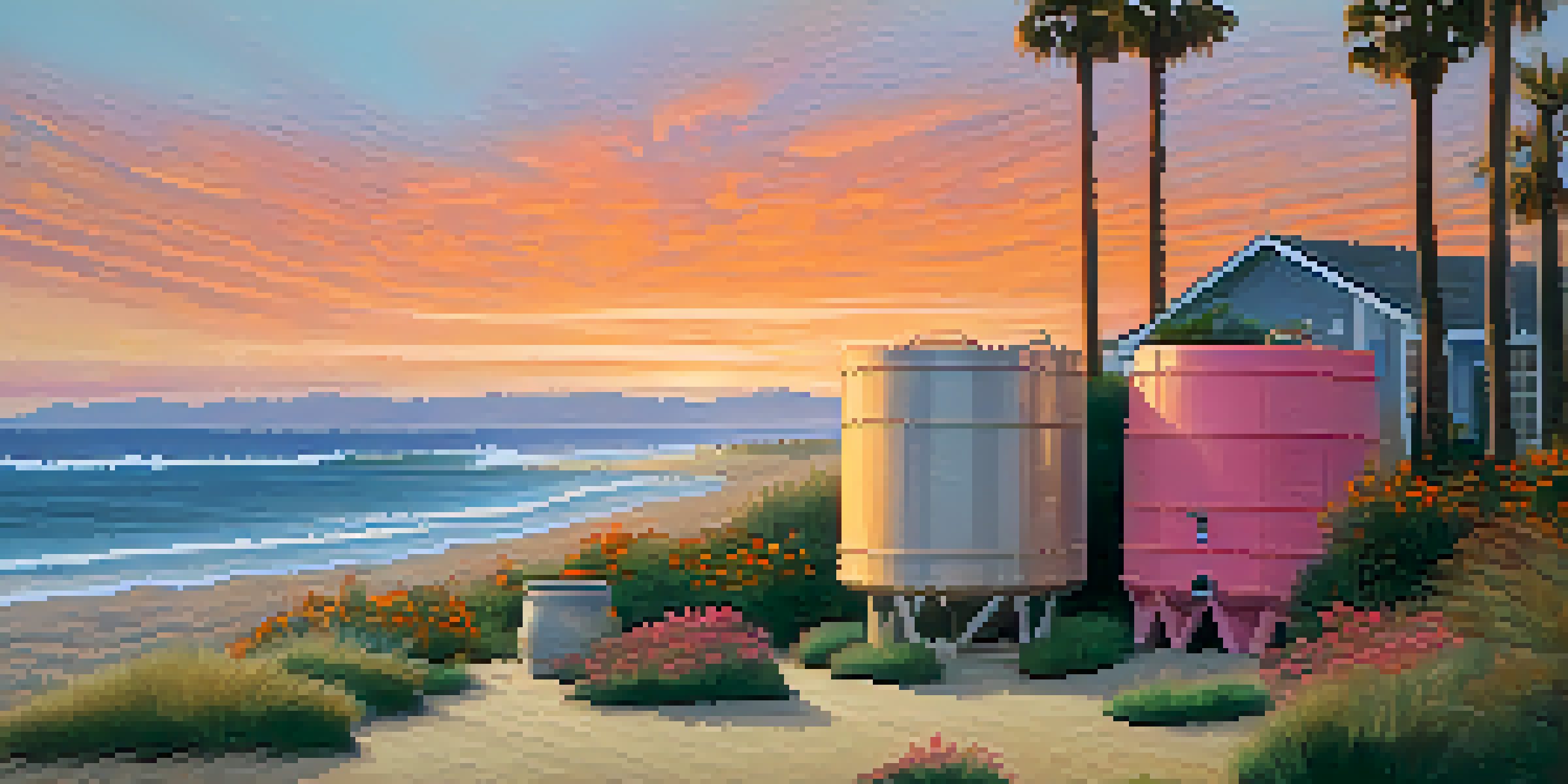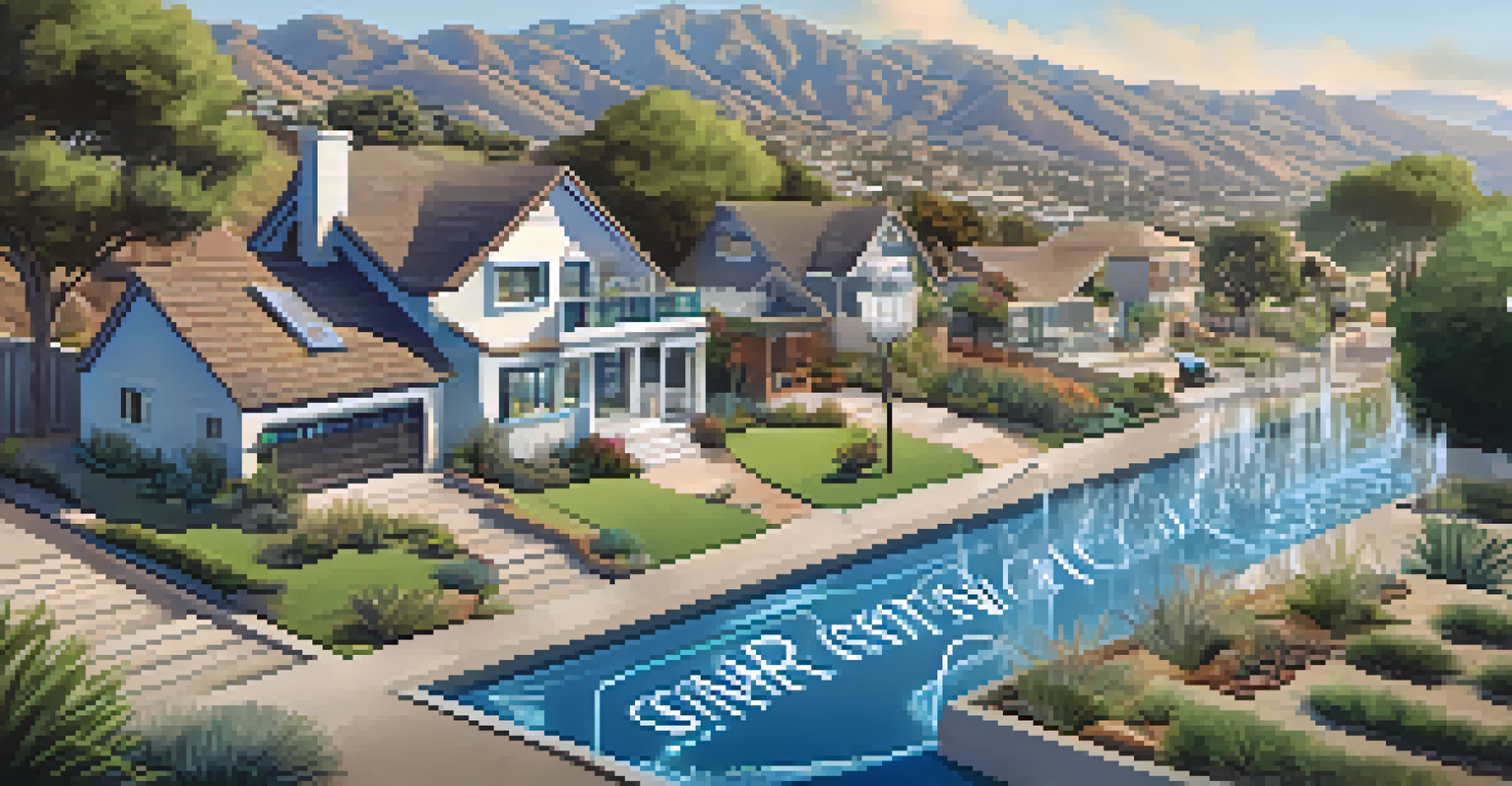Water Scarcity: Solutions to Malibu's Drought Issues

Understanding the Causes of Water Scarcity in Malibu
Malibu, known for its stunning beaches and luxury homes, faces a growing water scarcity issue. Factors like climate change, population growth, and prolonged droughts have strained the local water supply. As the region becomes hotter and drier, the demand for water continues to outpace what the natural environment can provide.
We do not inherit the earth from our ancestors, we borrow it from our children.
In addition to natural causes, human activities exacerbate the situation. Urban development often leads to increased water consumption, with lush lawns and swimming pools becoming common sights in this coastal city. This makes it essential for residents and local governments to recognize the importance of sustainable water practices.
Understanding these causes is the first step toward finding solutions. By acknowledging the unique challenges Malibu faces, we can begin to explore innovative strategies that not only address water scarcity but also promote a healthier environment for future generations.
Rainwater Harvesting: A Sustainable Approach
One promising solution to water scarcity in Malibu is rainwater harvesting. This practice involves collecting and storing rainwater from rooftops for later use, significantly reducing reliance on municipal water sources. With Malibu experiencing seasonal rains, capturing this precious resource can help alleviate some of the pressure on local water supplies.

Implementing rainwater harvesting systems is relatively simple and can be tailored to fit various home designs. Homeowners can install gutters and storage tanks to collect rainwater, which can then be used for irrigation, flushing toilets, and even drinking water after proper filtration. This not only conserves water but also helps to lower utility bills.
Addressing Water Scarcity in Malibu
Malibu faces water scarcity due to climate change, population growth, and unsustainable water practices.
Moreover, rainwater harvesting contributes to a more sustainable community. As more residents adopt this practice, the collective impact can lead to a significant reduction in water demand, ultimately benefiting the entire region.
Native Landscaping: A Water-Efficient Choice
Another effective strategy for addressing water scarcity is the implementation of native landscaping. By using plants that are naturally adapted to the local climate, Malibu residents can create beautiful outdoor spaces that require less water. Native plants are drought-resistant and can thrive with minimal irrigation, making them an excellent choice for water-conscious homeowners.
The greatest threat to our planet is the belief that someone else will save it.
In addition to conserving water, native landscaping promotes biodiversity and supports local wildlife. This approach not only enhances the beauty of a property but also contributes to the overall health of the ecosystem. By choosing plants that are suited to the environment, residents can create a sustainable landscape that flourishes without excessive water use.
Educating the community about the benefits of native landscaping can inspire more residents to make the switch. Local workshops and resources can help homeowners learn about the best plants for their gardens, fostering a culture of conservation and environmental awareness.
Water Recycling: Closing the Loop
Water recycling, also known as graywater reuse, is an innovative solution that Malibu can implement to combat water scarcity. This involves treating and reusing wastewater from sinks, showers, and washing machines for irrigation and non-potable uses. By recycling water, Malibu can significantly reduce its overall water consumption.
Installing graywater systems may require some upfront investment, but the long-term savings on water bills can be substantial. Homeowners can divert water from their household activities back into their gardens, ensuring that plants receive the hydration they need without tapping into valuable drinking water supplies.
Innovative Solutions for Conservation
Strategies like rainwater harvesting and native landscaping can significantly reduce water consumption in the community.
Furthermore, promoting water recycling can help build a more resilient community. As more households adopt this practice, Malibu can move closer to becoming a sustainable city that values resource conservation and environmental responsibility.
Community Education: Spreading Awareness
Community education plays a crucial role in addressing water scarcity in Malibu. By raising awareness about the importance of water conservation, residents can learn how their daily choices impact the local water supply. Teaching simple strategies, like fixing leaks and using water-efficient appliances, can make a significant difference in overall water usage.
Local workshops and events can provide residents with practical tips and resources for conserving water. Engaging the community in discussions about sustainable practices fosters a sense of ownership and responsibility towards the environment. When individuals feel empowered to make changes, the collective impact can be profound.
Creating a culture of conservation in Malibu will not only help address current water scarcity but also ensure that future generations have access to this essential resource. By working together, the community can foster a sustainable future where water is valued and preserved.
Government Policies: Supporting Sustainable Practices
Effective government policies are essential for addressing water scarcity in Malibu. Local authorities can implement regulations that promote water-efficient practices, such as requiring new developments to include sustainable landscaping or rainwater harvesting systems. By establishing guidelines, the government can lead the way in fostering a culture of conservation.
Incentives for homeowners who adopt water-saving technologies, such as rebates for installing efficient appliances, can further encourage sustainable practices. By making it financially viable for residents to conserve water, the community can work collectively towards reducing overall consumption.
Community Engagement is Essential
Educating residents and fostering a culture of conservation are vital for ensuring sustainable water use in Malibu.
Additionally, government initiatives can raise awareness about the importance of water conservation. Through campaigns and partnerships with local organizations, authorities can help educate residents on the critical need for sustainable water use, ensuring that Malibu remains a beautiful and thriving community.
Innovative Technologies: Advancing Water Conservation
Advancements in technology present exciting opportunities for water conservation in Malibu. Smart irrigation systems, for instance, can optimize water usage by adjusting watering schedules based on real-time weather data. This technology minimizes waste and ensures that plants receive the right amount of water at the right time.
Moreover, mobile apps and online platforms can help residents track their water usage and identify areas for improvement. By providing insights into consumption patterns, these tools empower individuals to make informed decisions about their water use. This increased awareness can lead to more responsible behaviors and a significant reduction in overall consumption.

Embracing innovative technologies can foster a culture of sustainability in Malibu. As residents become more engaged with their water usage, the community can work together to find solutions that benefit both the environment and its inhabitants.
Looking Ahead: A Sustainable Future for Malibu
As Malibu faces ongoing water scarcity challenges, it is crucial to adopt a multifaceted approach that combines education, technology, and community engagement. By implementing solutions such as rainwater harvesting, native landscaping, and water recycling, residents can help create a more sustainable future. Each small action contributes to a larger goal of preserving this precious resource.
Collaboration between residents, local governments, and organizations will be key in driving these initiatives forward. By working together, Malibu can become a model for other communities facing similar water scarcity issues. The collective effort will not only ensure a stable water supply but also create a stronger sense of community.
Ultimately, a sustainable future for Malibu hinges on the commitment of its residents to prioritize water conservation. With dedication and innovation, this beautiful coastal city can thrive while respecting and preserving its natural resources.